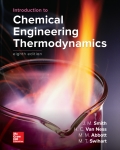
(a)
Interpretation:
Calculate the change in enthalpy
Concept Introduction:
During the heat transferred in the process, total mass and volume remains constant. So, the total volume after the heat addedis same as total volume at
(a)
Answer to Problem 6.37P
Explanation of Solution
Given information:
It is given that at initial state
And at final state,
From steam tables of superheated steam in Appendix E, table E.2
At pressure
At pressure
Since, pressure
At
At
At
At
Now, From linear double interpolation, if
So,
Similarly, enthalpy is
And entropy
Hence,
Change in entropy and enthalpy is,
And
(b)
Interpretation:
Calculate the change in enthalpy
Concept Introduction:
The change in enthalpy and entropy in ideal gas is defined as:
...(1a)
And
....(1b)
Where,
.....(2a)
Such that
And from Appendix D,
.....(2b)
Where
(b)
Answer to Problem 6.37P
Explanation of Solution
Given information:
It is given that at initial state
And at final state,
Values of above constants are given in appendix C table C.1 and noted down below:
So, from equation (2a)
Put the values
Now put the value in equation (1a),
Now, from equation (2b)
Put the values,
Now put the value in equation (1b),
(c)
Interpretation:
Calculate the change in enthalpy
Concept Introduction:
The change in enthalpy and entropy according to generalized correlationsare defined as:
...(1a)
And
....(1b)
Where,
.....(2a)
And
.....(2b)
(c)
Answer to Problem 6.37P
Explanation of Solution
Given information:
It is given that at initial state
And at final state,
From equation (2a),
Here
Properties of pure species of steam are given in Table B.1 Appendix B as water,
For initial state
So,
And
For differentiative terms in equation (2a),
So,
From equation (2a),
Similarly, for final state
And
So,
And
For differentiative terms in equation (2a),
So,
From equation (2a),
Now, change in enthalpy will be according to generalized correlations,
Now from equation (2b),
Similarly
Hence,
Want to see more full solutions like this?
Chapter 6 Solutions
EBK INTRODUCTION TO CHEMICAL ENGINEERIN
 Introduction to Chemical Engineering Thermodynami...Chemical EngineeringISBN:9781259696527Author:J.M. Smith Termodinamica en ingenieria quimica, Hendrick C Van Ness, Michael Abbott, Mark SwihartPublisher:McGraw-Hill Education
Introduction to Chemical Engineering Thermodynami...Chemical EngineeringISBN:9781259696527Author:J.M. Smith Termodinamica en ingenieria quimica, Hendrick C Van Ness, Michael Abbott, Mark SwihartPublisher:McGraw-Hill Education Elementary Principles of Chemical Processes, Bind...Chemical EngineeringISBN:9781118431221Author:Richard M. Felder, Ronald W. Rousseau, Lisa G. BullardPublisher:WILEY
Elementary Principles of Chemical Processes, Bind...Chemical EngineeringISBN:9781118431221Author:Richard M. Felder, Ronald W. Rousseau, Lisa G. BullardPublisher:WILEY Elements of Chemical Reaction Engineering (5th Ed...Chemical EngineeringISBN:9780133887518Author:H. Scott FoglerPublisher:Prentice Hall
Elements of Chemical Reaction Engineering (5th Ed...Chemical EngineeringISBN:9780133887518Author:H. Scott FoglerPublisher:Prentice Hall
 Industrial Plastics: Theory and ApplicationsChemical EngineeringISBN:9781285061238Author:Lokensgard, ErikPublisher:Delmar Cengage Learning
Industrial Plastics: Theory and ApplicationsChemical EngineeringISBN:9781285061238Author:Lokensgard, ErikPublisher:Delmar Cengage Learning Unit Operations of Chemical EngineeringChemical EngineeringISBN:9780072848236Author:Warren McCabe, Julian C. Smith, Peter HarriottPublisher:McGraw-Hill Companies, The
Unit Operations of Chemical EngineeringChemical EngineeringISBN:9780072848236Author:Warren McCabe, Julian C. Smith, Peter HarriottPublisher:McGraw-Hill Companies, The





